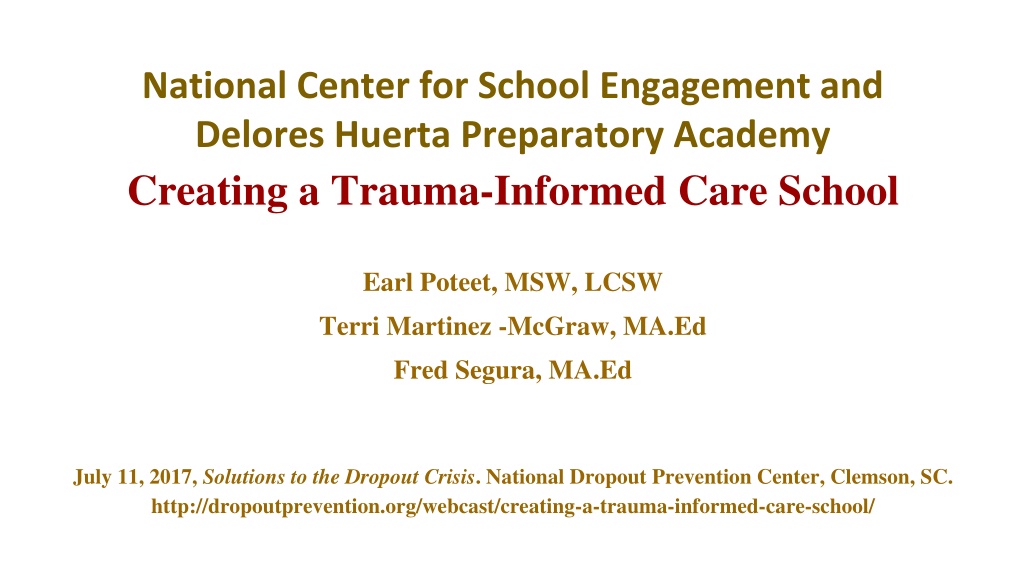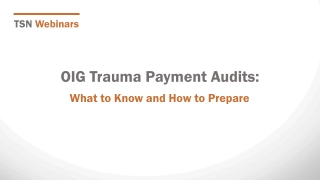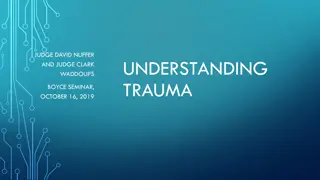Understanding Trauma-Informed Care in Education
The article discusses the impact of trauma on students and the importance of creating a trauma-informed learning environment. It explains the stress response, the freeze response, and the long-term effects of trauma, highlighting the need for supportive relationships, safety, and positive behavior support systems in schools to help traumatized students learn effectively.
Download Presentation

Please find below an Image/Link to download the presentation.
The content on the website is provided AS IS for your information and personal use only. It may not be sold, licensed, or shared on other websites without obtaining consent from the author. Download presentation by click this link. If you encounter any issues during the download, it is possible that the publisher has removed the file from their server.
E N D
Presentation Transcript
National Center for School Engagement and Delores Huerta Preparatory Academy Creating a Trauma-Informed Care School Earl Poteet, MSW, LCSW Terri Martinez -McGraw, MA.Ed Fred Segura, MA.Ed July 11, 2017, Solutions to the Dropout Crisis. National Dropout Prevention Center, Clemson, SC. http://dropoutprevention.org/webcast/creating-a-trauma-informed-care-school/
Stress Response The amygdala sends a message to the sympathetic nervous system through the hypothalamus, which in turn sends two sets of chemical messages that are simultaneous (fight/flight and body tasks); the adrenal glands then trigger release of adrenaline for the cardiovascular and nervous systems (activating the heart, lungs, and large muscle groups); and also releases cortisol through the pituitary gland.
Freeze A response to helplessness in the face of both hyper-arousal and cornered (Karr-Morse & Wiley, 2012). The response of trauma is reactivated by reminders or thoughts of the original event, including worrying or dreaming about it. These ruminations trigger the same cavalcade of internal responses as the original response. If it occurs often enough, it may generalize so that even subtle reminders are enough to trigger the full HPA response, re-stimulating the child s helplessness each time (Karr-Morse & Wiley, 2012). Karr-Morse, R., & Wiley, M. Scared Sick: The role of childhood trauma in adult disease. Philadelphia: Basic Books, 2012.
Long-Term Effects When a chemical state of fear persist over time in early development, the chemistry of trauma can become permanently set. Such children will always be on red alert for signs of danger. HPA systems that are constantly being over- stimulated by internal or external reminders pull a child s attention away from other forms of learning. These become the children who can t sit still in school because they are busy subliminally monitoring the environment for signs of danger rather than calmly listening to the teacher. They will often perceive even benign behaviors as hostile and they are ready to respond. Or they become the kids who don t know what s asked because they simply aren t there. Teacher talk doesn t penetrate these little brains, which have tuned out and gone away to safe places inside themselves (Karr-Morse & Wiley, 2012). Karr-Morse, R., & Wiley, M. Scared Sick: The role of childhood trauma in adult disease. Philadelphia: Basic Books, 2012.
Creating a Trauma-Informed Learning Environment Relationships Safety Ask what happened, not what s wrong Meet and greet Develop your positive behavior support system Professional development
Helping Traumatized Students Learn Help children regulate emotions to master social and academic skills Maintain high academic standards Help children feel safe Manage behavior and set limits Reduce bullying and harassment Help children have a sense of agency Build on strengths Understand the connection between behavior and emotion Avoid labels
Teach Problem-Solving Skills Through gentle guidance and open-ended questions, support children in resolving their own conflicts by learning resolution skills and nonviolent ways of playing, working, and communicating with others. Acknowledge children s problem-solving attempts whether or not the attempts are successful. Encourage them to think ahead by discussing challenges they would face in carrying out their plans and help them consider how they can prevent or solve them. Suggest taking breaks when children are stuck or when they are getting frustrated. Provide choices when possible. Model the exact words to use, particularly when they are in new situations.
Putting It All Into Practice Dolores Huerta Preparatory High School Minority Rate Over 85% (Primarily Hispanic) Free and Reduced Lunch Rate 79% Truancy and absenteeism Above 20% Most students from single parent households or being raised by grandparents Disrespect and insubordination greatest behavioral issues
Putting It All Into Practice Dolores Huerta Preparatory High School Graduation Rate for Free and Reduced Lunch Students 82% in 4 years 94.6% in 5 years 97.8% in 6 years Graduation Rate for Minority Students 78% in 4 years 95% in 5 years 96% in 6 years
Putting It All Into Practice Dolores Huerta Preparatory High School Implementations for the 2016 2017 school year School structure to address Trauma-Informed Care Love and Logic Training for all secondary employees Teaching and Learning Framework STARS Peer Mentoring Suicide Prevention Assembly























